Mariposa Grove Part I
About a week ago - February 19th, 2006. 
My Father and I were looking to take a winter hike in the snow. I figured cross-country skis would be the way to go for some snow photos. My friend Brian had mentioned Mariposa Grove as a cross-country ski destination. Only a few problems: 1) I hadn't cross-country skied for almost 10 years and even then I was pretty unskilled, 2) My dad had never cross-country skiid, 3) we had no ski gear. But the Grove is only 2 miles from the Wawona Entrance parking lot and we should be able to rent equipment, right? Not so easy in Fresno I'm afraid. Here's what I learned. Only one store still rents cross-country skiis in Fresno: Herb Bauers. And they were out of our boot size. So we opted for snowshoes instead. Not half as much fun downhill, but a little easier uphill.
 Once we arrived at the trailhead (the gate blocks off the Mariposa Grove road right after the Wawona Entrance station during the Winter) we could see that snowshoes weren't even necessary. People were hiking up with tennis shoes on. There was plenty of snow - at least a foot but between a service truck and dozens of skiiers travelling the road, it had plenty of tamping down to make a nice frozen pavement.
Once we arrived at the trailhead (the gate blocks off the Mariposa Grove road right after the Wawona Entrance station during the Winter) we could see that snowshoes weren't even necessary. People were hiking up with tennis shoes on. There was plenty of snow - at least a foot but between a service truck and dozens of skiiers travelling the road, it had plenty of tamping down to make a nice frozen pavement.
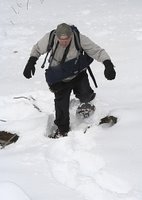
Off the trail the snow was very powdery and the snowshoes came in handy. We made a lot of stops for photos and walked along various trails and roads in the Grove. We also enjoyed some funny people watching. One guy had his 10 year old daughter with him on skiis. Apparently she got tired and whiny so an unacquainted young couple offered to tow her up by her ski pole baskets - a low tech ski lift. After letting her off near the top they complained to each other that she was 'too young' to bring up there. Ha! That 10-year old girl probably has more energy than those two adults put together. As my Dad pointed out she was also much smarter.
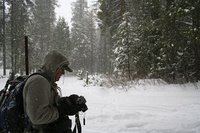 Although the trail that day was much more busy than we usually experience (especially for a Winter hike), it was easy to see why, being at the main entrance to a National Park on a perfect snow day. I would recommend the trail to just about anyone in decent health. It's a little tougher with snow and if you carry a lot of gear (like we do) but overall it's a fairly easy hike. And even with all the traffic it was pretty easy to walk out into the snow to get some isolation. Most stay on the main route.
Although the trail that day was much more busy than we usually experience (especially for a Winter hike), it was easy to see why, being at the main entrance to a National Park on a perfect snow day. I would recommend the trail to just about anyone in decent health. It's a little tougher with snow and if you carry a lot of gear (like we do) but overall it's a fairly easy hike. And even with all the traffic it was pretty easy to walk out into the snow to get some isolation. Most stay on the main route.
 Now to the photography. There's a few images that I think while not the best in quality offer a platform for discussing some of my thoughts on my photosophy (made-up word). A lot of people including those who appreciate and make nature photographs believe that nature photos should not be manipulated at all. Some have an almost religious belief that the reality should be conveyed as-is. Things like filters or time-lapse are gimmicks to be avoided and change the scene from what was visually there.
Now to the photography. There's a few images that I think while not the best in quality offer a platform for discussing some of my thoughts on my photosophy (made-up word). A lot of people including those who appreciate and make nature photographs believe that nature photos should not be manipulated at all. Some have an almost religious belief that the reality should be conveyed as-is. Things like filters or time-lapse are gimmicks to be avoided and change the scene from what was visually there.
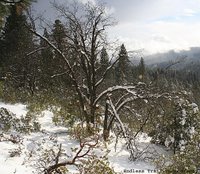 I think after you look through some of my photos you will find I am not one of those people. I have no problem with that approach. I think strict reproductionists have to employ great skill to be successful. It's just not realistic to me to think that a camera can completely reproduce human vision anyway. Film is notorious for reducing contrast (from 11 'stops' that humans can see to 5 'stops' on slide film). And you don't want to go down the road of color comparisons. No two printing methods even have the same color gamut. But the bottom line for me is that photography is like any other art. It's a way of producing a vision in the mind of the artist. That may take the artist down many paths using filters, exposure modification or even photoshop software tricks. I hardly use any photoshop tricks other than sharpening and color adjustment. That's not because I think it's wrong or too much. I just don't know how to use the software very well yet.
I think after you look through some of my photos you will find I am not one of those people. I have no problem with that approach. I think strict reproductionists have to employ great skill to be successful. It's just not realistic to me to think that a camera can completely reproduce human vision anyway. Film is notorious for reducing contrast (from 11 'stops' that humans can see to 5 'stops' on slide film). And you don't want to go down the road of color comparisons. No two printing methods even have the same color gamut. But the bottom line for me is that photography is like any other art. It's a way of producing a vision in the mind of the artist. That may take the artist down many paths using filters, exposure modification or even photoshop software tricks. I hardly use any photoshop tricks other than sharpening and color adjustment. That's not because I think it's wrong or too much. I just don't know how to use the software very well yet.
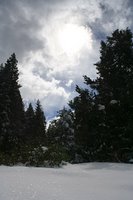 To me what sets an artist apart is their creativity and style. A painting can be both very 'photorealistic' demonstrating great technical skill and lifeless at the same time. But successful artists can remold reality to their vision rather than the other way around. Through composition, and stylization and even creation of novel content a great artist can produce something that we can't see in everyday life. Or they can make us see something of everyday life in a new way. For me I know I'm nowhere near that stage yet in my photography and I'm even farther away in drawing, but that's what I'm shooting for someday. Most of the time I really don't care if my photograph of a sunset doesn't look just like it would have if you had been there to see it too. What I want is to take elements of that sunset that interest me and share them with you. Sometimes if I'm lucky and patient and I can even get my camera to show you aspects of that sunset that I couldn't even 'see' at that moment.
To me what sets an artist apart is their creativity and style. A painting can be both very 'photorealistic' demonstrating great technical skill and lifeless at the same time. But successful artists can remold reality to their vision rather than the other way around. Through composition, and stylization and even creation of novel content a great artist can produce something that we can't see in everyday life. Or they can make us see something of everyday life in a new way. For me I know I'm nowhere near that stage yet in my photography and I'm even farther away in drawing, but that's what I'm shooting for someday. Most of the time I really don't care if my photograph of a sunset doesn't look just like it would have if you had been there to see it too. What I want is to take elements of that sunset that interest me and share them with you. Sometimes if I'm lucky and patient and I can even get my camera to show you aspects of that sunset that I couldn't even 'see' at that moment.
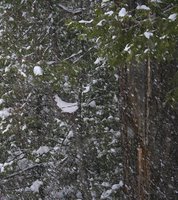 I have a very simple pair of photographs to illustrate a little of what I mean though neither are stunners. The first (right) is a fast shutter speed (1/100th sec.) photo of snow falling on cedars. The shutter speed is just slow enough to convey a sense of movement as the flakes are slightly blurred. Click on any photo to see it larger. In the second shot (below) the shutter speed is much slower (1/8 sec., my favorite speed for moving water photos) allowing the flakes to streak across the scene, not at all the way a human eye sees it. But does that make the photo worse? What do you think? Click on the 'X Comments' (where X is the number of comments received) link to give feedback.
I have a very simple pair of photographs to illustrate a little of what I mean though neither are stunners. The first (right) is a fast shutter speed (1/100th sec.) photo of snow falling on cedars. The shutter speed is just slow enough to convey a sense of movement as the flakes are slightly blurred. Click on any photo to see it larger. In the second shot (below) the shutter speed is much slower (1/8 sec., my favorite speed for moving water photos) allowing the flakes to streak across the scene, not at all the way a human eye sees it. But does that make the photo worse? What do you think? Click on the 'X Comments' (where X is the number of comments received) link to give feedback.
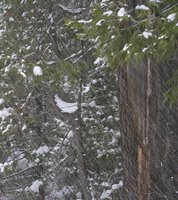 You can visit my photo gallery at BetterPhoto.com to see better examples of photos that aren't very close to typical human vision (and some that are). One photo ('Reach') looks more like what I see with my glasses off (extremely myopic). A few show long exposures of water that create a streaks of flow or a cloud of light. Several shots use close-up photography to show detail the naked eye can't quite see (even with glasses on).
You can visit my photo gallery at BetterPhoto.com to see better examples of photos that aren't very close to typical human vision (and some that are). One photo ('Reach') looks more like what I see with my glasses off (extremely myopic). A few show long exposures of water that create a streaks of flow or a cloud of light. Several shots use close-up photography to show detail the naked eye can't quite see (even with glasses on).
An artist that did a much better job photosophizing than I can was Galen Rowell. Through his magazine articles, books and body of work he demonstrated a keen sense of the science and art of perception.
You'll notice I call this posting Mariposa Grove Part I. Part II is soon to follow with a few more photos and a lot less words.
All photos in this post were taken with a Canon Digital Rebel XT.

My Father and I were looking to take a winter hike in the snow. I figured cross-country skis would be the way to go for some snow photos. My friend Brian had mentioned Mariposa Grove as a cross-country ski destination. Only a few problems: 1) I hadn't cross-country skied for almost 10 years and even then I was pretty unskilled, 2) My dad had never cross-country skiid, 3) we had no ski gear. But the Grove is only 2 miles from the Wawona Entrance parking lot and we should be able to rent equipment, right? Not so easy in Fresno I'm afraid. Here's what I learned. Only one store still rents cross-country skiis in Fresno: Herb Bauers. And they were out of our boot size. So we opted for snowshoes instead. Not half as much fun downhill, but a little easier uphill.
 Once we arrived at the trailhead (the gate blocks off the Mariposa Grove road right after the Wawona Entrance station during the Winter) we could see that snowshoes weren't even necessary. People were hiking up with tennis shoes on. There was plenty of snow - at least a foot but between a service truck and dozens of skiiers travelling the road, it had plenty of tamping down to make a nice frozen pavement.
Once we arrived at the trailhead (the gate blocks off the Mariposa Grove road right after the Wawona Entrance station during the Winter) we could see that snowshoes weren't even necessary. People were hiking up with tennis shoes on. There was plenty of snow - at least a foot but between a service truck and dozens of skiiers travelling the road, it had plenty of tamping down to make a nice frozen pavement.
Off the trail the snow was very powdery and the snowshoes came in handy. We made a lot of stops for photos and walked along various trails and roads in the Grove. We also enjoyed some funny people watching. One guy had his 10 year old daughter with him on skiis. Apparently she got tired and whiny so an unacquainted young couple offered to tow her up by her ski pole baskets - a low tech ski lift. After letting her off near the top they complained to each other that she was 'too young' to bring up there. Ha! That 10-year old girl probably has more energy than those two adults put together. As my Dad pointed out she was also much smarter.
 Although the trail that day was much more busy than we usually experience (especially for a Winter hike), it was easy to see why, being at the main entrance to a National Park on a perfect snow day. I would recommend the trail to just about anyone in decent health. It's a little tougher with snow and if you carry a lot of gear (like we do) but overall it's a fairly easy hike. And even with all the traffic it was pretty easy to walk out into the snow to get some isolation. Most stay on the main route.
Although the trail that day was much more busy than we usually experience (especially for a Winter hike), it was easy to see why, being at the main entrance to a National Park on a perfect snow day. I would recommend the trail to just about anyone in decent health. It's a little tougher with snow and if you carry a lot of gear (like we do) but overall it's a fairly easy hike. And even with all the traffic it was pretty easy to walk out into the snow to get some isolation. Most stay on the main route. Now to the photography. There's a few images that I think while not the best in quality offer a platform for discussing some of my thoughts on my photosophy (made-up word). A lot of people including those who appreciate and make nature photographs believe that nature photos should not be manipulated at all. Some have an almost religious belief that the reality should be conveyed as-is. Things like filters or time-lapse are gimmicks to be avoided and change the scene from what was visually there.
Now to the photography. There's a few images that I think while not the best in quality offer a platform for discussing some of my thoughts on my photosophy (made-up word). A lot of people including those who appreciate and make nature photographs believe that nature photos should not be manipulated at all. Some have an almost religious belief that the reality should be conveyed as-is. Things like filters or time-lapse are gimmicks to be avoided and change the scene from what was visually there. I think after you look through some of my photos you will find I am not one of those people. I have no problem with that approach. I think strict reproductionists have to employ great skill to be successful. It's just not realistic to me to think that a camera can completely reproduce human vision anyway. Film is notorious for reducing contrast (from 11 'stops' that humans can see to 5 'stops' on slide film). And you don't want to go down the road of color comparisons. No two printing methods even have the same color gamut. But the bottom line for me is that photography is like any other art. It's a way of producing a vision in the mind of the artist. That may take the artist down many paths using filters, exposure modification or even photoshop software tricks. I hardly use any photoshop tricks other than sharpening and color adjustment. That's not because I think it's wrong or too much. I just don't know how to use the software very well yet.
I think after you look through some of my photos you will find I am not one of those people. I have no problem with that approach. I think strict reproductionists have to employ great skill to be successful. It's just not realistic to me to think that a camera can completely reproduce human vision anyway. Film is notorious for reducing contrast (from 11 'stops' that humans can see to 5 'stops' on slide film). And you don't want to go down the road of color comparisons. No two printing methods even have the same color gamut. But the bottom line for me is that photography is like any other art. It's a way of producing a vision in the mind of the artist. That may take the artist down many paths using filters, exposure modification or even photoshop software tricks. I hardly use any photoshop tricks other than sharpening and color adjustment. That's not because I think it's wrong or too much. I just don't know how to use the software very well yet. To me what sets an artist apart is their creativity and style. A painting can be both very 'photorealistic' demonstrating great technical skill and lifeless at the same time. But successful artists can remold reality to their vision rather than the other way around. Through composition, and stylization and even creation of novel content a great artist can produce something that we can't see in everyday life. Or they can make us see something of everyday life in a new way. For me I know I'm nowhere near that stage yet in my photography and I'm even farther away in drawing, but that's what I'm shooting for someday. Most of the time I really don't care if my photograph of a sunset doesn't look just like it would have if you had been there to see it too. What I want is to take elements of that sunset that interest me and share them with you. Sometimes if I'm lucky and patient and I can even get my camera to show you aspects of that sunset that I couldn't even 'see' at that moment.
To me what sets an artist apart is their creativity and style. A painting can be both very 'photorealistic' demonstrating great technical skill and lifeless at the same time. But successful artists can remold reality to their vision rather than the other way around. Through composition, and stylization and even creation of novel content a great artist can produce something that we can't see in everyday life. Or they can make us see something of everyday life in a new way. For me I know I'm nowhere near that stage yet in my photography and I'm even farther away in drawing, but that's what I'm shooting for someday. Most of the time I really don't care if my photograph of a sunset doesn't look just like it would have if you had been there to see it too. What I want is to take elements of that sunset that interest me and share them with you. Sometimes if I'm lucky and patient and I can even get my camera to show you aspects of that sunset that I couldn't even 'see' at that moment. I have a very simple pair of photographs to illustrate a little of what I mean though neither are stunners. The first (right) is a fast shutter speed (1/100th sec.) photo of snow falling on cedars. The shutter speed is just slow enough to convey a sense of movement as the flakes are slightly blurred. Click on any photo to see it larger. In the second shot (below) the shutter speed is much slower (1/8 sec., my favorite speed for moving water photos) allowing the flakes to streak across the scene, not at all the way a human eye sees it. But does that make the photo worse? What do you think? Click on the 'X Comments' (where X is the number of comments received) link to give feedback.
I have a very simple pair of photographs to illustrate a little of what I mean though neither are stunners. The first (right) is a fast shutter speed (1/100th sec.) photo of snow falling on cedars. The shutter speed is just slow enough to convey a sense of movement as the flakes are slightly blurred. Click on any photo to see it larger. In the second shot (below) the shutter speed is much slower (1/8 sec., my favorite speed for moving water photos) allowing the flakes to streak across the scene, not at all the way a human eye sees it. But does that make the photo worse? What do you think? Click on the 'X Comments' (where X is the number of comments received) link to give feedback. You can visit my photo gallery at BetterPhoto.com to see better examples of photos that aren't very close to typical human vision (and some that are). One photo ('Reach') looks more like what I see with my glasses off (extremely myopic). A few show long exposures of water that create a streaks of flow or a cloud of light. Several shots use close-up photography to show detail the naked eye can't quite see (even with glasses on).
You can visit my photo gallery at BetterPhoto.com to see better examples of photos that aren't very close to typical human vision (and some that are). One photo ('Reach') looks more like what I see with my glasses off (extremely myopic). A few show long exposures of water that create a streaks of flow or a cloud of light. Several shots use close-up photography to show detail the naked eye can't quite see (even with glasses on).An artist that did a much better job photosophizing than I can was Galen Rowell. Through his magazine articles, books and body of work he demonstrated a keen sense of the science and art of perception.
You'll notice I call this posting Mariposa Grove Part I. Part II is soon to follow with a few more photos and a lot less words.
All photos in this post were taken with a Canon Digital Rebel XT.

0 Comments:
Post a Comment
<< Home